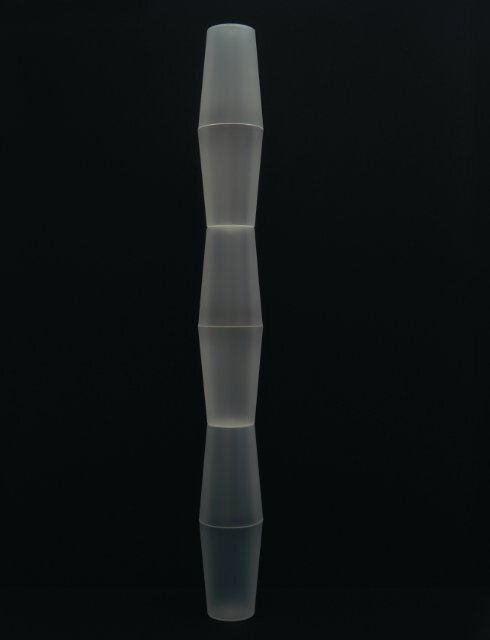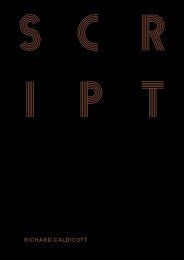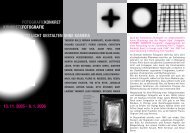Untitled - Richard Caldicott
Untitled - Richard Caldicott
Untitled - Richard Caldicott
Create successful ePaper yourself
Turn your PDF publications into a flip-book with our unique Google optimized e-Paper software.
left: <strong>Richard</strong> <strong>Caldicott</strong>, New Work,<br />
<strong>Untitled</strong> 31, 2008, courtesy of<br />
Hamiltons Gallery<br />
THE THINGS<br />
THEY ARE<br />
Derek Horton discusses <strong>Richard</strong> <strong>Caldicott</strong>’s series, <strong>Untitled</strong> 2008<br />
<strong>Richard</strong> <strong>Caldicott</strong>’s new series of works, <strong>Untitled</strong><br />
2008, is at once both a return and a new<br />
departure: the series marks a return to the object,<br />
but with a new found assertiveness in the sheer visual<br />
presence of the object’s centrality that is essentially<br />
sculptural. The constructed facture of all <strong>Caldicott</strong>’s<br />
previous photographs means, of course, that the object<br />
has never really gone away: even in the architecturally<br />
inspired compositions of 2003 or the geometric<br />
abstractions of the Loop series of 2005 or the Script series<br />
of 2006, the images are always dependent on the<br />
objective manipulation of physical material. But not since<br />
the works employing Tupperware, made mostly during<br />
the 1990s, has the photographed object been so evidently<br />
visible. Though this return to a means of construction<br />
wherein the component objects utilised in the<br />
photographs remain recognisable is only a part of what<br />
distinguishes this new series from <strong>Caldicott</strong>’s other<br />
recent work.<br />
The everyday plastic objects from which the images are<br />
made are transformed into resonant new columnar objects<br />
that read simultaneously as iconic sculptural forms and as<br />
the central focus of photographs in which the dense black<br />
ground against which they are seen takes on an equally<br />
weighty presence.The repeated motif is a kind of Twenty-<br />
First Century nod to Brancusi’s Endless Column that forms<br />
the Newman-like stripe or Flavin-like strip down the centre<br />
of a minimalist rectilinear composition. A less obvious but<br />
equally pertinent comparison is with the patterns of<br />
repeated pictorial elements in the 1960s Composites<br />
photographs of Ray K Metzker. 1<br />
art of england 59
ight top <strong>Richard</strong> <strong>Caldicott</strong>, New<br />
Work, <strong>Untitled</strong> 23, 2008, courtesy<br />
of Hamiltons Gallery<br />
right bottom <strong>Richard</strong> <strong>Caldicott</strong>,<br />
New Work, <strong>Untitled</strong> 20, 2008,<br />
courtesy of Hamiltons Gallery<br />
One of the characteristics of the kinds of plastics from<br />
which the mass-produced things utilised in these<br />
photographs are made is that their colour is embodied in<br />
their material, so that colour and form become indivisible.<br />
The difference between a thing that is coloured and a thing<br />
to which colour has been applied is immediately<br />
recognisable and perceptually very significant (think for<br />
instance of the difference between the painted planes and<br />
bars of a Rietveld chair and the moulded plastic<br />
‘colourform’ of an Eames plastic chair).The objective unity<br />
of colour and form inherent in the material production of<br />
this series is central to its object-like sculptural qualities<br />
that are unique in <strong>Caldicott</strong>’s recent work. This<br />
characteristic of coloured plastic means that even when the<br />
material is transparent enough to allow light through, it<br />
retains its colour and consequently affects the colour of the<br />
light. Photography is, of course, a light-based medium but<br />
the particular use of light in these works exploits the<br />
varying densities of the plastics and their colourings in a play<br />
between opaque and transparent forms.This reinforces the<br />
instability of spatial divisions and an ambiguity between<br />
flatness and depth. Given the way that the mundane<br />
functional origins of the things from which these<br />
photographs are made remain visible even as they are<br />
transformed into objects of contemplation, this play<br />
between opaque and transparent forms is paralleled by a<br />
play between the literal world and abstract form.<br />
It may seem at odds with the abstract and formalist nature<br />
of <strong>Caldicott</strong>’s oeuvre to quote a documentary street<br />
photographer in relation to his work, but Gary Winogrand’s<br />
assertion that he took photographs “to find out what things<br />
will look like photographed” is relevant here. 2 And,crucially,<br />
what <strong>Caldicott</strong> finds out is that they can look very different<br />
to the things they are. Winogrand also said, speaking of<br />
Walker Evans, that “his photographs are about how what is<br />
photographed is changed by being photographed and how<br />
things exist in photographs”. 3 This is very much the case in<br />
relation to the mundane things used by <strong>Caldicott</strong>, but if his<br />
photographs are ‘about’ anything, as opposed to being the<br />
things they are themselves, they are about the power of the<br />
imagination to transform the material world of objects that<br />
surrounds us and create sensuous, elegant and pristinely<br />
new things from it.<br />
A photographer perhaps closer to <strong>Caldicott</strong>’s sensibilities,<br />
Aaron Siskind, has said,“When I make a photograph I want<br />
it to be an altogether new object, complete and selfcontained,<br />
whose basic condition is order, unlike the world<br />
of events and actions, whose permanent condition is<br />
change and disorder”. 4 The order in these self-contained<br />
new objects of <strong>Caldicott</strong>’s is one that derives from his<br />
usual discipline and restraint, a minimalist aesthetic that<br />
works within the constraints of the simplest of structures<br />
and forms whilst imbuing them with a sensual richness<br />
that borders on decadence. Like a kind of alchemy, the<br />
production of these works uses technological processes<br />
to transform uniform components that are themselves the<br />
products of industrialised manufacture into singular<br />
objects that generate a separate existence from a mass of<br />
copies. Varying between densely coloured opacity,<br />
translucence and reflective brilliance, their surfaces<br />
generate a seductive richness that belies both the<br />
austerity of their origins and the simplicity of their form.<br />
In this they are the epitome of ‘cool’, in the sense that it<br />
has been defined by Dave Hickey as “minimalism<br />
redeemed with eros and atmosphere”. 5<br />
60<br />
art of england
1<br />
Relevant examples of Ray K Metzker’s Composites<br />
include Philly Walk (1965), Car and Street Lamp (1966),<br />
Yikes (1966) and Stairburst (1969).<br />
2<br />
Garry Winogrand, ‘Monkeys Make the Problem More<br />
Difficult’: A Collective Interview with Garry Winogrand,<br />
transcribed by Dennis Longwell, in Peninah R. Petruck [ed.],<br />
The Camera Viewed: Writings on Twentieth Century<br />
Photography,Vol.II, New York: Dutton, 1979 (p.127)<br />
3<br />
Garry Winogrand in Walker Evans, The Hungry Eye,<br />
London:Thames & Hudson, 1993 (p.12)<br />
4<br />
Aaron Siskind in Brooks Johnson [ed.], Photography<br />
Speaks, New York:Aperture, 2004 (p.184)<br />
5<br />
Dave Hickey,Cool on Cool:William Claxton and the Way<br />
the Music Looked, in Elizabeth Armstrong [ed.], Birth of the<br />
Cool: California Art, Design and Culture at Mid-century,<br />
Newport Beach California: Orange County Museum of Art<br />
and Prestel Publishing, 2007 (p.137)<br />
NEW WORK by <strong>Richard</strong> Coldicott runs 21 January – 21<br />
February 2009 at Hamiltons Gallery, 13 Carlos Place, London,<br />
W1K 2EU. Telephone: +44 (0) 207 499 9493.<br />
www.hamiltonsgallery.com<br />
left <strong>Richard</strong> <strong>Caldicott</strong>, New Work,<br />
<strong>Untitled</strong> 3, 2008, courtesy of<br />
Hamiltons Gallery<br />
Each image is an edition of 15, and<br />
each image size is 50 x 40 inches.<br />
art of england 61




